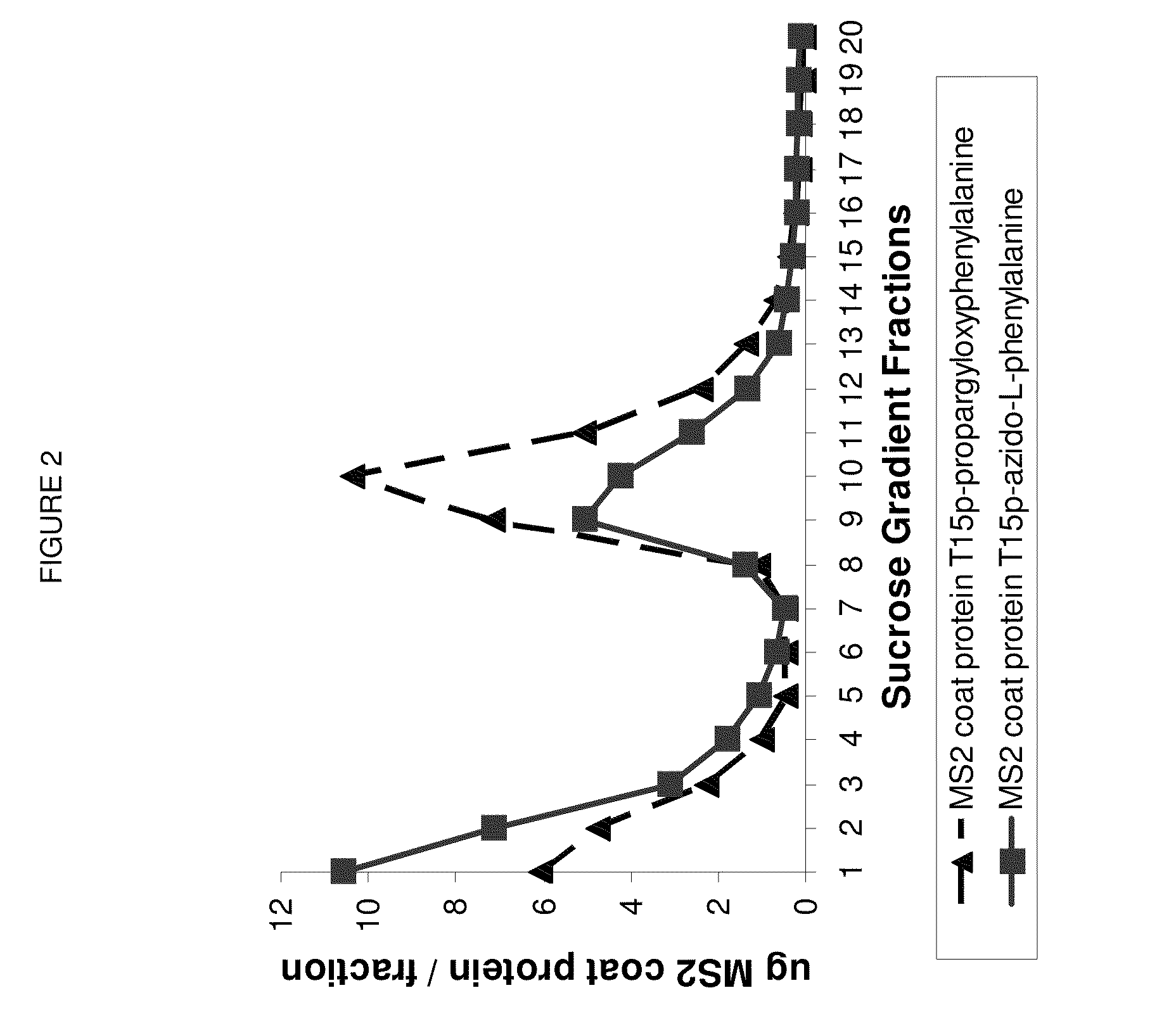Direct Attachment of Polypeptides to Virus Like Particles
a technology of virus like particles and polypeptides, which is applied in the direction of peptides, antibody medical ingredients, peptide sources, etc., can solve the problems of protein with multiple unnatural amino acids, low yield in eukaryotic cell-free systems,
- Summary
- Abstract
- Description
- Claims
- Application Information
AI Technical Summary
Problems solved by technology
Method used
Image
Examples
example 1
Synthesis of Optimized MS2 Gene
Materials and Methods
[0084]Plasmid Construction. With two-step PCR and custom oligonucleotides (Operon Technologies, USA), a ACG15TAG (amber stop codon) substitution was mutated into the MS2 coat protein sequence using the plasmid pET24a-MS2 cp (Bundy and Swartz 2008 Biotechnol Bioeng 100(1):28-37). The change substitutes a stop codon (TAG) for the natural occurring threonine at amino acid location #15. The mutated sequence was ligated into the pET24a(+) vector (Novagen, USA) at the Nde I and Sal I restriction sites and named pMS2-T15Amb. The vector was transformed into DH5α cells (One Shot MAXX Efficiency DH5α-T1R Competent Cells, Invitrogen) and the plasmid was purified with Qiagen Plasmid Maxi Kit (Qiagen, Valencia, Calif.) for use in cell-free protein synthesis reactions. The sequence is as follows.
[0085]The T15STOP substituted MS2 coat protein gene nucleotide sequence was optimized for expression in E. coli cell extracts. This gene was inserted us...
example 2
Expression of MS2 Coat Protein Containing an Unnatural Amino Acid
[0086]PANOx-SP Cell-free Expression System. Modified PANOx-SP cell-free reactions were 30 μL in volume and were incubated at 30° C. for 8 hr in 1.5 ml eppendorf tubes. The reaction includes the following components: 1.2 mM ATP, 0.85 mM each of GTP, UTP, and CTP, 34 μg / mL folinic acid, 171 μg / mL E. coli tRNA mixture, 12 nM pET24aMS2_T15STOP plasmid, 100 μg / mL T7 RNA polymerase, 5 μM [U-14C]-Leucine, 2 mM each of 20 unlabeled amino acids, 2 mM p-azido-phenylalanine or 2 mM p-propargyloxyphenylalanine (synthesized as described by Dieters 2005), between 150 μg / mL and 5 mg / mL of pure Methanococcus jannaschii mutated tyrosine synthetase mutated for selective recognition of p-azido-L-phenylalanine or p-propargyloxyphenylalanine, 0.33 mM nicotinamide adenine dinucleotide (NAD), 0.27 mM coenzyme A (CoA), 30 mM phosphoenolpyruvate, 1.5 mM spermidine, 1 mM putrescine, 170 mM potassium glutamate, 10 mM ammonium glutamate, 20 mM ma...
example 3
Demonstrating Assembly of MS2 VLP with 180 Accessible p-Azido-Phenylalanines or p-propargyloxyphenylalanines
[0092]Dialysis. To remove unincorporated I-[U-4C] leucine, the cell-free product (produced as described in example 2 but produced using a 1 mL thin film reaction instead of the 15 μl scale) was dialyzed in 6-8000 MWCO Specra / Pro Molecularporous Membrane Tubing (Spectrum Labs) against 300 mL 10 mM Bis-Tris-HCl, 375 mM sodium chloride, 5 mM ethylenediaminetetraacetic acid, pH between 5.8 and 6.8) overnight with 2 buffer exchanges.
[0093]Velocity Sedimentation Analysis. The dialyzed cell-free reaction product was layered on top of a linear gradient of sucrose ranging from 10% to 40% w / v sucrose and centrifuged at 31,000 rpm in a Beckman-Coulter SW-32 swinging bucket rotor (Fullerton, Calif.) in a Beckman L8-M ultracentrifuge at 4° C. for 3.5 hr with “slow” acceleration and deceleration (profile 7). 0.5 mL fractions were collected using a Teledyne Isco Foxy Jr. Density Gradient Fra...
PUM
| Property | Measurement | Unit |
|---|---|---|
| concentrations | aaaaa | aaaaa |
| concentrations | aaaaa | aaaaa |
| concentrations | aaaaa | aaaaa |
Abstract
Description
Claims
Application Information
 Login to View More
Login to View More - R&D
- Intellectual Property
- Life Sciences
- Materials
- Tech Scout
- Unparalleled Data Quality
- Higher Quality Content
- 60% Fewer Hallucinations
Browse by: Latest US Patents, China's latest patents, Technical Efficacy Thesaurus, Application Domain, Technology Topic, Popular Technical Reports.
© 2025 PatSnap. All rights reserved.Legal|Privacy policy|Modern Slavery Act Transparency Statement|Sitemap|About US| Contact US: help@patsnap.com



